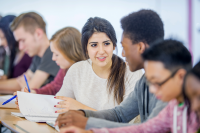Scaffolding Social Action for Your Students
A framework for guiding middle schoolers to plan and engage in social action that’s relevant in their coursework and their lives.
Your content has been saved!
Go to My Saved Content.Students Taking Action Together (STAT) is a pedagogy tailored to help middle school students plan and, when appropriate, engage in feasible, personally meaningful social action within the existing social studies, history, civics, and current events curriculum.
Right now, as we see a heightened sense of activism and civic participation among students, there are two realities:
• What we are hearing now is still the voices of a numerical minority of students.
• Even those students who are active may lack the skills that would most help them be more thoughtful, effective, and successful.
Students Taking Action Together is currently in place in seven urban middle schools in New Jersey, and it is making a difference. Social action can be encouraged with regard to current events such as gun violence in schools or issues such as cheating, gang presence, or bullying, but it can also be encouraged in thinking about historical events. Students can explore, for example, such issues from history as the treatment of Native Americans during the westward expansion or the development of the New Deal.
The basic pedagogy is a problem-solving strategy we use that goes by the acronym PLAN:
Problem: Create a problem description that defines the issue being discussed
List: Brainstorm a list of options to solve the problem
Action: Develop and act on an action plan to solve the problem
Notice: Notice successes as part of ongoing evaluation and refinement
If an existing social and emotional learning (SEL) program has a problem-solving process, and it’s working, schools should continue onward. But if not, PLAN is easy and applicable to many aspects of learning—in the classroom and in the larger school community.
Exploring Current Issues
To help their students consider the most recent school shooting, teachers at one New Jersey middle school used the PLAN strategy with their classes, taking the perspective of the students in the school where the tragedy occurred:
P: Who were the individuals involved? What was the problem from different perspectives? What feelings did they have?
L: What options did they consider to be acceptable ways to address the problem? What did they ultimately decide?
A: How did they carry out that plan? What obstacles did they encounter?
N: How did it work out? What more needs to be done? What can be learned from their experience? What social action can be taken by the class, in the class, in the school, in the community, etc., to address this problem?
The discussions these questions lead to are rich and often motivate students to get more information, check their facts, and listen to classmates who may not see the problem, or the solution, in the same way.
Investigating Issues From the Past
Teachers also applied PLAN to a historical event. Here is a simplified version of what a teacher used as an orienting discussion, prior to detailed reading on the Civil War:
P: How did the North and the South define the problem in the country? What were the issues, from each perspective? Who were the key people involved in making important decisions?
L: What options did they consider to be acceptable ways to resolve the problem? What did they ultimately decide?
A: How did they carry out that plan? What obstacles did they encounter?
N: How did it work out? What can be learned from their experiences that are relevant to the present?
Metacognitive Growth and Self-Reflection
With the PLAN strategy, teachers guide the discussions of both historical and contemporary issues while also engaging students in deep reflection.
- Responsible listening: Can you accurately summarize what you just heard one of your classmates say?
- Respectful empathic debate: Can you argue from the perspective of all sides of an issue, especially ones that you disagree with, understanding various points of view?
- Collaborative creativity: Can you generate a variety of ideas regarding how else the problem could have been viewed in the past, or could be viewed in the present? What other solutions might have been/might be considered based on an alternate view?
- Reflective improvement: Can you reflect on what was learned from taking this kind of look at a historical or current event or school problem?
Where the Social Action Starts
Next, teachers ask students to consider who might be interested in learning about their perspective. How might they reach that audience? What format or product might be most appropriate for reaching that audience?
The idea of a student or community march, for example, is one choice, and it’s valuable for students to generate a list of things a march might accomplish, what it may leave undone, and how to address this. Students determine what constituencies they would like to reach. And, if not through a march, how might they move their social action ideas into reality and reach their intended audience? Some suggestions:
- Write a letter to a newspaper
- Send something to the victims or relatives
- Reach out to an elected official
- Conduct a school or community debate
The Rutgers Social-Emotional and Character Development Lab is piloting the Students Taking Action Together framework with the goal of introducing it and supporting its use in other middle schools in New Jersey.
